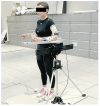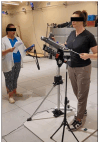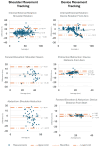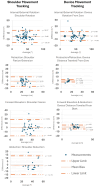The Reliability and Validity of an Instrumented Device for Tracking the Shoulder Range of Motion
- PMID: 40573705
- PMCID: PMC12197020
- DOI: 10.3390/s25123818
The Reliability and Validity of an Instrumented Device for Tracking the Shoulder Range of Motion
Abstract
Rotator cuff tears are common in individuals over 40, and physical therapy is often prescribed post-surgery. However, access can be limited by cost, convenience, and insurance coverage. CuffLink is a telehealth rehabilitation system that integrates the Strengthening and Stabilization System mechanical exerciser with the interACTION mobile health platform. The system includes a triple-axis accelerometer (LSM6DSOX + LIS3MDL FeatherWing), a rotary encoder, a VL530X time-of-flight sensor, and two wearable BioMech Health IMUs to capture upper-limb motion. CuffLink is designed to facilitate controlled, home-based exercise while enabling clinicians to remotely monitor joint function. Concurrent validity and test-retest reliability were used to assess device accuracy and repeatability. The results showed moderate to good validity for shoulder rotation (ICC = 0.81), device rotation (ICC = 0.94), and linear tracking (from zero: ICC = 0.75 and RMSE = 2.41; from start: ICC = 0.88 and RMSE = 2.02) and good reliability (e.g., RMSEs as low as 1.66 cm), with greater consistency in linear tracking compared to angular measures. Shoulder rotation and abduction exhibited higher variability in both validity and reliability measures. Future improvements will focus on manufacturability, signal stability, and force sensing. CuffLink supports accessible, data-driven rehabilitation and holds promise for advancing digital health in orthopedic recovery.
Keywords: inertial measurement unit; reliability; rotator cuff repair; validity.
Conflict of interest statement
Jim Grant is a co-inventor of the intellectual property (IP) associated with the Strengthening and Stabilization System, which was being adapted for the CuffLink project within this study. He is also the President of ēlizur. ēlizur has licensed interACTION, a system developed by the University of Pittsburgh’s Health and Rehabilitation Informatics (HARI) Lab, for use in this study. The interACTION platform was also being adapted for the CuffLink project. Additionally, Stephany N. Lang and Erica Tatko are currently employed, and Jennifer Lambiase was formerly employed by ēlizur. The remaining authors declare no competing interests.
Figures






Similar articles
-
Multimedia article. The arthroscopic management of partial-thickness rotator cuff tears: a systematic review of the literature.Arthroscopy. 2011 Apr;27(4):568-80. doi: 10.1016/j.arthro.2010.09.019. Arthroscopy. 2011. PMID: 21296545
-
Manual therapy and exercise for rotator cuff disease.Cochrane Database Syst Rev. 2016 Jun 10;2016(6):CD012224. doi: 10.1002/14651858.CD012224. Cochrane Database Syst Rev. 2016. PMID: 27283590 Free PMC article.
-
The effectiveness of diagnostic tests for the assessment of shoulder pain due to soft tissue disorders: a systematic review.Health Technol Assess. 2003;7(29):iii, 1-166. doi: 10.3310/hta7290. Health Technol Assess. 2003. PMID: 14567906
-
Physiotherapy interventions for shoulder pain.Cochrane Database Syst Rev. 2003;2003(2):CD004258. doi: 10.1002/14651858.CD004258. Cochrane Database Syst Rev. 2003. PMID: 12804509 Free PMC article.
-
Kinesio taping for rotator cuff disease.Cochrane Database Syst Rev. 2021 Aug 8;8(8):CD012720. doi: 10.1002/14651858.CD012720.pub2. Cochrane Database Syst Rev. 2021. PMID: 34365646 Free PMC article.
References
-
- Kuhn J. Prevalence, Natural History, and Nonoperative Treatment of Rotator Cuff Disease. Oper. Tech. Sports Med. 2023;31:150978. doi: 10.1016/j.otsm.2023.150978. - DOI
-
- Thigpen C.A., Shaffer M.A., Gaunt B.W., Leggin B.G., Williams G.R., Wilcox R.B., III The American Society of Shoulder and Elbow Therapists’ consensus statement on rehabilitation following arthroscopic rotator cuff repair. J. Shoulder Elb. Surg. 2016;25:521–535. doi: 10.1016/j.jse.2015.12.018. - DOI - PubMed
MeSH terms
Grants and funding
LinkOut - more resources
Full Text Sources

